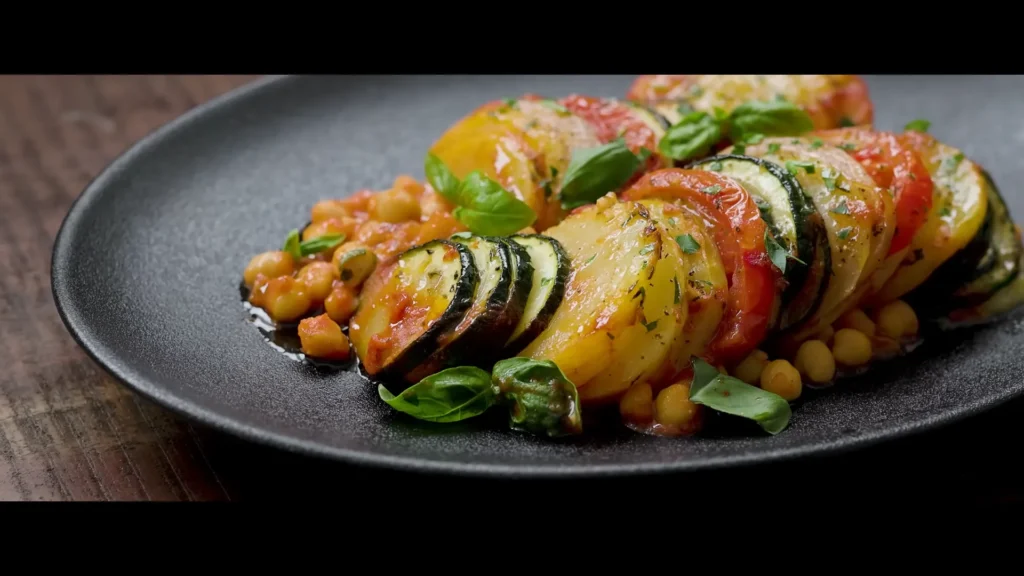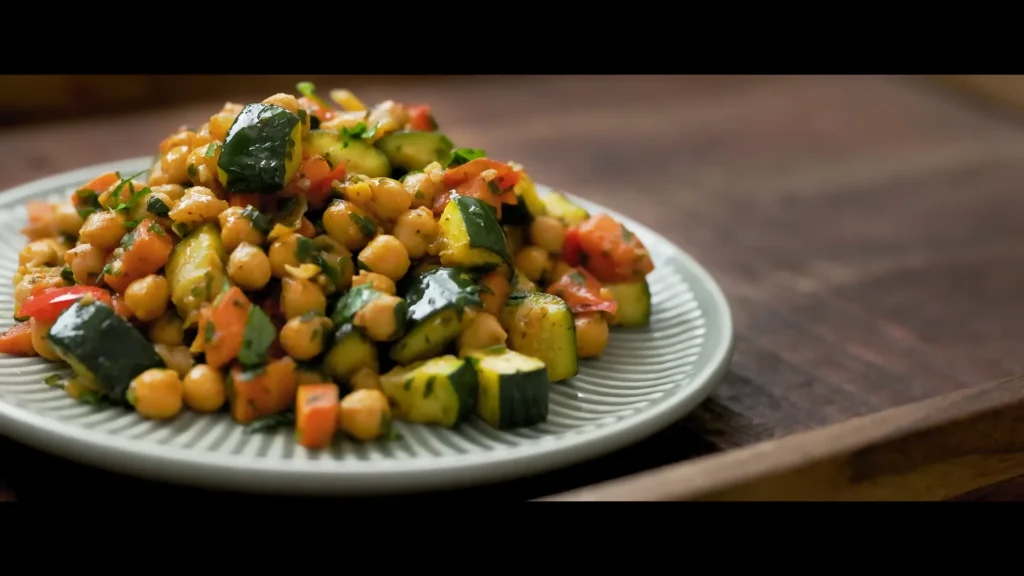Table of Contents

Introduction
In a world where sustainability and ethical choices play a pivotal role, veganism is on the rise. If you’re a food enthusiast and looking to explore the world of plant-based cuisine, you’ve come to the right place. This article will guide you on how to create a unique and delectable vegan recipe that stands out from the rest.
Ingredients:
- 1 can (15 oz) chickpeas, drained and rinsed
- 2 cups broccoli florets
- 1 red bell pepper, sliced
- 1 yellow bell pepper, sliced
- 1 cup snap peas, trimmed
- 1 medium carrot, thinly sliced
- 1 cup mushrooms, sliced
- 3 cloves garlic, minced
- 1-inch piece of ginger, minced
- 2 tablespoons soy sauce
- 2 tablespoons Sriracha sauce (adjust to your spice preference)
- 1 tablespoon maple syrup
- 1 tablespoon sesame oil
- 2 tablespoons vegetable oil
- Salt and black pepper to taste
- Cooked brown rice or noodles for serving
Instructions:
- Prepare the Sauce: In a small bowl, whisk together the soy sauce, Sriracha sauce, maple syrup, and sesame oil. Set aside.
- Sauté the Vegetables: Heat the vegetable oil in a large skillet or wok over medium-high heat. Add the garlic and ginger and sauté for about 30 seconds until fragrant.
- Add the Vegetables: Add the broccoli, red bell pepper, yellow bell pepper, snap peas, carrot, and mushrooms to the skillet. Stir-fry the vegetables for 5-7 minutes, or until they are tender but still crisp.
- Add Chickpeas: Add the chickpeas to the skillet and cook for an additional 2-3 minutes until they are heated through.
- Pour in the Sauce: Pour the sauce you prepared earlier over the vegetables and chickpeas. Stir well to coat everything evenly. Cook for another 2-3 minutes, allowing the sauce to thicken slightly.
- Season: Taste the stir-fry and season with salt and black pepper to your liking. Adjust the Sriracha sauce for more heat if desired.
- Serve: Serve your spicy chickpea and vegetable stir-fry over cooked brown rice or noodles. Garnish with sesame seeds or sliced green onions if desired.
Step-by-Step Recipe Guide
Here’s a step-by-step guide to creating your unique vegan recipe:
Step 1: Choose Your Base
Select a primary ingredient or base for your dish. This could be vegetables, legumes, grains, or a combination.
Step 2: Flavor Profile
Decide on the flavor profile you want. Will it be spicy, savory, sweet, or a unique fusion?
Step 3: Unique Ingredient
Add an unexpected ingredient that will surprise and delight your taste buds.
Step 4: Cooking Techniques
Experiment with various cooking techniques like roasting, sautéing, or even grilling.
Step 5: Presentation
Don’t underestimate the importance of presentation. A beautifully plated dish is as appetizing as it is delicious.
Adding a Twist to Traditional Flavors
One of the joys of vegan cooking is taking traditional flavors and giving them a unique twist. For instance, you can create a creamy vegan alfredo sauce using cashews and nutritional yeast.
Presentation Matters: The Art of Plating
The way you present your dish can elevate the dining experience. Use fresh herbs, colorful vegetables, and artistic garnishes to make your creation visually appealing.
Savoring Your Culinary Creation
As a chef, you should savor your own creation. It’s important to enjoy the fruits of your labor.
Sharing Your Vegan Masterpiece
Share your unique vegan recipe with friends and family. Encourage others to try plant-based dishes and discover the beauty of vegan cuisine.
Sustainability in Vegan Cooking
Vegan cooking aligns with sustainability. By choosing plant-based ingredients, you’re making a positive impact on the environment.
Nutritional Benefits of Vegan Recipes
Vegan recipes are not only delicious but also packed with nutrients. They are often low in saturated fats and cholesterol, making them a healthy choice.
Veganism Beyond the Kitchen
Veganism extends beyond your culinary creations. It’s a lifestyle that influences your choices in clothing, cosmetics, and more.
Challenges and Solutions
While vegan cooking is rewarding, it comes with its own set of challenges. Ingredient availability and misconceptions can be obstacles, but with determination, these can be overcome.
Conclusion
In conclusion, crafting a unique vegan recipe is an art that combines creativity, compassion, and culinary expertise. By experimenting with ingredients and presentation, you can create dishes that not only taste delicious but also make a positive impact on the world.

